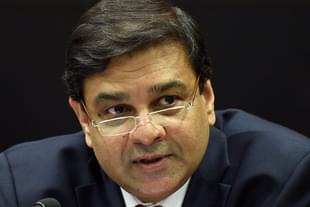Economy
Silent Urjit Patel Speaks Through Inaction; Declines Rate Cuts For Now
R Jagannathan
Dec 07, 2016, 04:25 PM | Updated 04:25 PM IST
Save & read from anywhere!
Bookmark stories for easy access on any device or the Swarajya app.


Urjit Patel’s second monetary policy can be read as a clear assertion of the Reserve Bank of India’s autonomy, something that was seen as compromised when legal tender status was withdrawn for old Rs 1,000 and Rs 500 notes on 8 November.
Announcing the bi-monthly policy today (7 December) after a meeting of the six-member Monetary Policy Committee (MPC), Patel dispelled the idea that the RBI was commandeered to back the government’s demonetisation decision. He announced no rate cut – the opposite of what was predicted by an overwhelming bunch of economists.
The MPC fully backed him (voting unanimously) in asserting that the temporary surge in liquidity due to demonetisation was no reason to cut interest rates again. The committee emphasised that non-food, non-fuel inflation was “resistant to downward impulses and could set the floor to headline inflation.” Its March 2017 inflation prediction is 5 per cent. The MPC estimated the price impact of demonetisation at barely 15 basis points (100 basis points make 1 per cent). It noted that “the withdrawal of SBN (specified bank notes, i.e., the old Rs 500 and Rs 1,000) could result in a possible temporary reduction of inflation of the order of 10-15 basis points in Q3.”
This shows that despite Prime Minister Narendra Modi and Finance Minister Arun Jaitley’s claims that demonetisation can bring down interest rates, the RBI has stood its ground and focused on inflation.
Earlier, Governor Patel sent the same message when he raised the cash reserve ratio (CRR) to 100 per cent for the 16 September to 11 November period, when demonetisation sent a flood of liquidity into the banking system. The government had to post-haste announce a Rs 6 lakh crore market stabilisation scheme (MSS) to soak this liquidity up, and Patel duly reduced CRR with effect from 10 December in his policy statement.
But there is one major contradiction in this policy: while the MPC pooh-poohed the likely drop in inflation due to demonetisation, it simultaneously downed the gross value added (GVA) growth forecast to 7.1 percent from 7.6 percent earlier.
One wonders why when growth is weakening, inflation should be seen as weakening less – and thus warranting a pause.
The only way to read this is as another assertion of autonomy. The RBI does not want to be seen as kowtowing to the government, and this is why even though there is a reasonably strong case for cutting rates, it has chosen not to.
The MPC statement had this to say:
The outlook for GVA growth for 2016-17 has turned uncertain after the unexpected loss of momentum by 50 basis points in Q2 and the effects of the withdrawal of SBNs which are still playing out. Downside risks in the near term could travel through two major channels: (a) short-run disruptions in economic activity in cash-intensive sectors such as retail trade, hotels and restaurants and transportation, and in the unorganised sector; (b) aggregate demand compression associated with adverse wealth effects. The impact of the first channel should, however, ebb with the progressive increase in the circulation of new currency notes and greater usage of non-cash based payment instruments in the economy, while the impact of the second channel is likely to be limited.
Reading between the lines, it is clear that the RBI is seeing less deceleration due to demonetisation and more due to the fundamental factors that may be slowing down the economy, as apparent in the second quarter GVA/GDP numbers.
This again is a contradiction. If growth is slowing for fundamental reasons, there is even more of a reason to cut rates, but the RBI has not done so. The RBI clearly does not want to be seen as being pushed by the executive.
The RBI was not very forthcoming on how soon the currency shortage will end. The numbers given were around Rs 4-lakh-and-odd crore of new currency notes printed, with more on the way. With the emphasis shifting to the printing of Rs 500 and Rs 100 notes, the RBI obviously believes that demand for the unusable Rs 2,000 notes will improve once change is made more easily available. Deputy Governor R Gandhi indicated that around Rs 11.44 lakh crore of demonetised currency had come back to the banking system out of the total Rs 15.44 lakh crore outstanding on 8 November.
We thus got no answer to the question of when the currency shortage will end, but the chances are that the shortfall will ebb only slowly, possibly by January-end or early February. Digital payments are supposed to make up for the slack in the meanwhile.
Another point Patel emphasised was that there would be no change in the RBI’s assets and liabilities just because some of the Rs 500 and Rs 1,000 notes do not return to the banking system. Economists have speculated that the non-returning currency will reduce the RBI’s liabilities, enabling it to pay the government a huge dividend from the resultant surpluses. Patel said the non-return of Rs 500 and Rs 1,000 notes have no implications for the balance-sheet as “only the legal tender character” of these notes had been changed.
Meaning, no bonanza for the government on this score. However, he perhaps meant that the only way to get the cash out of the RBI is if there is a surplus for the government to do so by law. The government can issue an order to reduce the RBI’s liabilities on this count by amending the RBI Act and get its special dividend. But Patel is not going to rush and do so on his own.
Jagannathan is former Editorial Director, Swarajya. He tweets at @TheJaggi.





